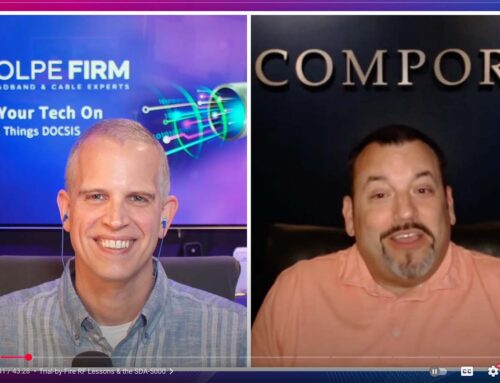Podcast: Play in new window | Download | Embed
Subscribe: Spotify | Email | RSS | More
Hello Everyone. This is episode 55 of Get Your Tech On, our show on All Things DOCSIS. I’m Brady Volpe, Founder of The Volpe Firm and Nimble This. John Downey is with me and also CMTS Technical Leader at Cisco Systems, and Ron Hranac also of Cisco Systems, welcome John and Ron.
Today we are going to discuss Top Commonly Misunderstood RF Measurements. An overall discussion on confusing topics and commonly misunderstood RF measurements in cable. Over 100 years of RF knowledge.
Topics Covered:
- Fun Math problem
- What is a dB (decide)?
- The dB by itself is merely the expression of power levels or ratio
- dBmv and expression of power in voltage ratios of power
- Express loss and gain in dB noise etc.
- Expressing signal levels you need to express dBmv
- dBm commonly used in Europe
- Quick conversion math discussed
- Absolute level needs the reference
- Take a coax cable and it’s split in the splitter power levels explained
- So if you turn the splitter around what happens?
- Power levels on a spectrum analyzer QAM channels have same power and analog channels.
- Signals have phase – understanding phase and length of cable
- Feed forward amplifiers
- RBW = resolution bandwidth filter, 10x the log of 6MHz
- On and analyzer if should appear 20 dB lower, 13 dB correction factor
- What does it mean to measure a QAM single power?
- Peak power components
- OFDM signal some people are forgetting to derate the analog lasers and could get laser clipping on the downstream and not realize it.
- OFDM is the equivalent of 32 analog channels push the laser over the edge.
- SNR and MER same or different – but different on the situation?
- Base band = raw audio, original video audio signals.
- Carrier to noise done in the RF domain
- RxMER explained
- OFDMA DOCSIS 3.1 is many many subcarriers. You need to look at all the subcarriers to get the measurement on the CMTS
- OFDM is a QAM signal
- Good MER with impulse noise, understanding the limits of test equipment
- FEC – forward error correction
- Code word errors and BER – bit error ratio / bit error rate differentiations between, per and post, QAM vs OFDM
- Further information on transmitting data in the upstream and downstream
- Reed Soloman
- Low density parity check – DOCSIS 3.0 and 3.1 error correction
- With DOCSIS 3.1 100% correctable FEC with LDPC and this is expected behavior
- Per and post means correctable and uncorrectable
- PNM and OFMDA
- MER can never be better then the carrier to noise ratio
End Podcast
John and Ron thank you for your time today. This was a great episode. Our next Episode 56 in February 21th at 2pm on DOCSIS 3.1 Channel Bonding.
We do our best to bring our audience great technical content every month. You can watch us live on the air or catch our recorded episodes on YouTube, on our volpefirm.com/events channel or download our audio only version with your favorite podcatcher.
If you have enjoyed this webcast, please do hit the subscribe button so that you never miss an episode.
Thank you so much for being here and we will see you next month.
We do our best to bring our audience great technical content every month. You can watch us live on the air or catch our recorded episodes on YouTube, on our volpefirm.com/events channel or download our audio only version with your favorite podcatcher.
If you have enjoyed this webcast, please do hit the subscribe button so that you never miss an episode.
Thank you so much for being here and we will see you next month.
Upcoming events can be seen under Broadband Events. Previous events can be seen under the blog.
- If you are watching this on youtube please hit the subscribe button!
- Let us know what you think and remember to share!
- You can find slides at the bottom of the page and some on slideshare.
- Find out about events or articles by following us on Twitter, LinkedIn or Facebook too.
Also available on iTunes, Google Podcasts, Spotify, vurbl see podcasts “get your tech on”.





Leave a Reply